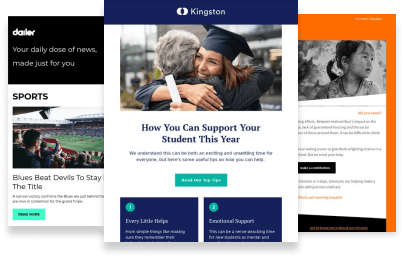Email newsletters are a win-win, benefiting companies and consumers alike. Why? Email newsletters give businesses a forum to send multiple messages to a captivated, qualified audience.
One of the best parts about email newsletters? Creating them is easy! The not-so-easy part? Generating content for newsletters month after month can prove challenging for even the most seasoned (and creative) marketer.
But, we’ve got your back. Here are 50 must-have ideas to spark your next email newsletter.
50 must-try newsletter ideas for your email content
1. Favorable articles about your company
It’s always a good idea to keep subscribers in the know about your company, and email newsletters are a perfect way to fill them in about recent milestones, awards, and good press. If your CEO is featured on the front page of the New York Times, don’t be afraid to share that with your newsletter audience!
2. Business changes that impact customers
Are you switching to a subscription model? Increasing your prices? Making an important business pivot like an acquisition or partnership? Shout it from the rooftops (or just email). Sharing business changes with your customer base is transparent and just plain good business practices.
For example, check out how Ahrefs, an SEO and digital marketing tool, announced their price increase and provided reasons (plus new benefits) for users.
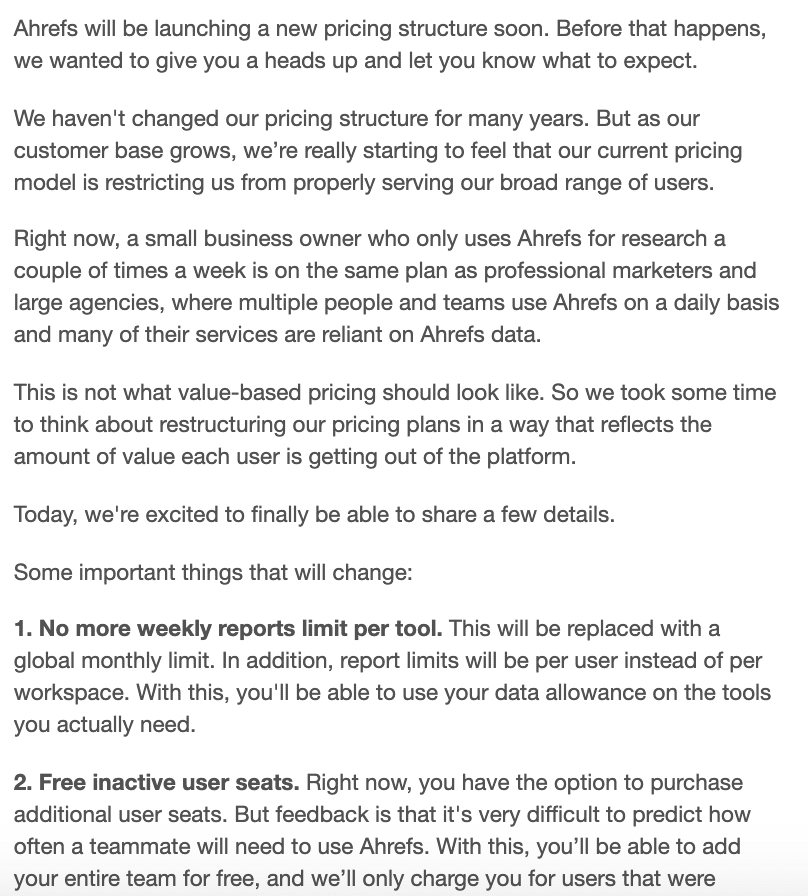
Source: Ahrefs
3. A company anniversary or milestone
Your email list wants to celebrate your successes with you, and why not pat yourself on the back every once in a while? If it’s your company’s “birthday” or ten-year anniversary of operating, you can draft up email content that shows off your milestone.
4. Recent award nominations or wins
Sharing your wins can also look like, well, awards you win. Say, for example, your website won a Webby Award, or your production company’s movie got picked for a Vimeo Staff Pick. Share that news with your subscribers!
5. A list of open positions for hire
If you’re hiring, an unexpected way to get qualified applicants might be from your email newsletter. Email can be a valuable distribution channel for B2B announcements in the same way as posting on job boards or Linkedin.
Take this playful email from Social Print Studio, for example, who mock up a poorly designed email — complete with Comic Sans and clip art! — to advertise they’re hiring a graphic designer.
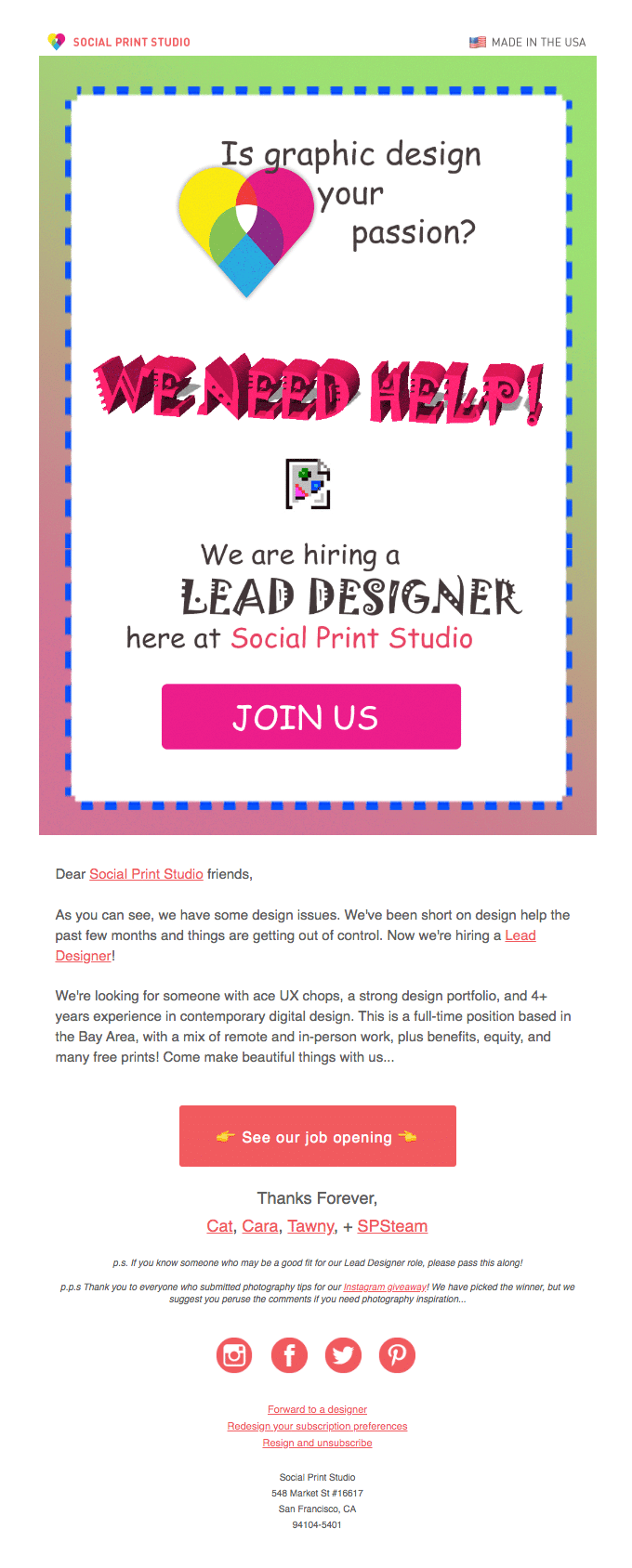
Source: Really Good Emails
6. Monthly business recap
This is a great way to show continued value to your board, shareholders, and employees, especially if you send an email to your entire internal list. The content can highlight profits, big wins, and more.
For a public-facing monthly recap, your email might look a little different. You might instead recap your top-selling products or share a list of your top-performing content.
7. A behind-the-scenes look at your company
There are tons of ways to show BTS content through your email newsletter. Going behind-the-scenes at your company might mean photographs from your company-wide events or happy hours, or video montages from colleagues sharing their favorite part about working together.
Or, you might use the newsletter content to tease a blog post outlining your company values. Either way, subscribers will appreciate a peek behind the curtain.
8. A message from the CEO
A message or letter from your company’s CEO can be a powerful tool in your email newsletter arsenal. Take, for instance, the way that American Airlines CEO Doug Parker shares the company’s adjustments and improvements in light of COVID-19.
This message expresses gravitas and empathy, showing how a personalized video from a CEO can be comforting in times of crisis.
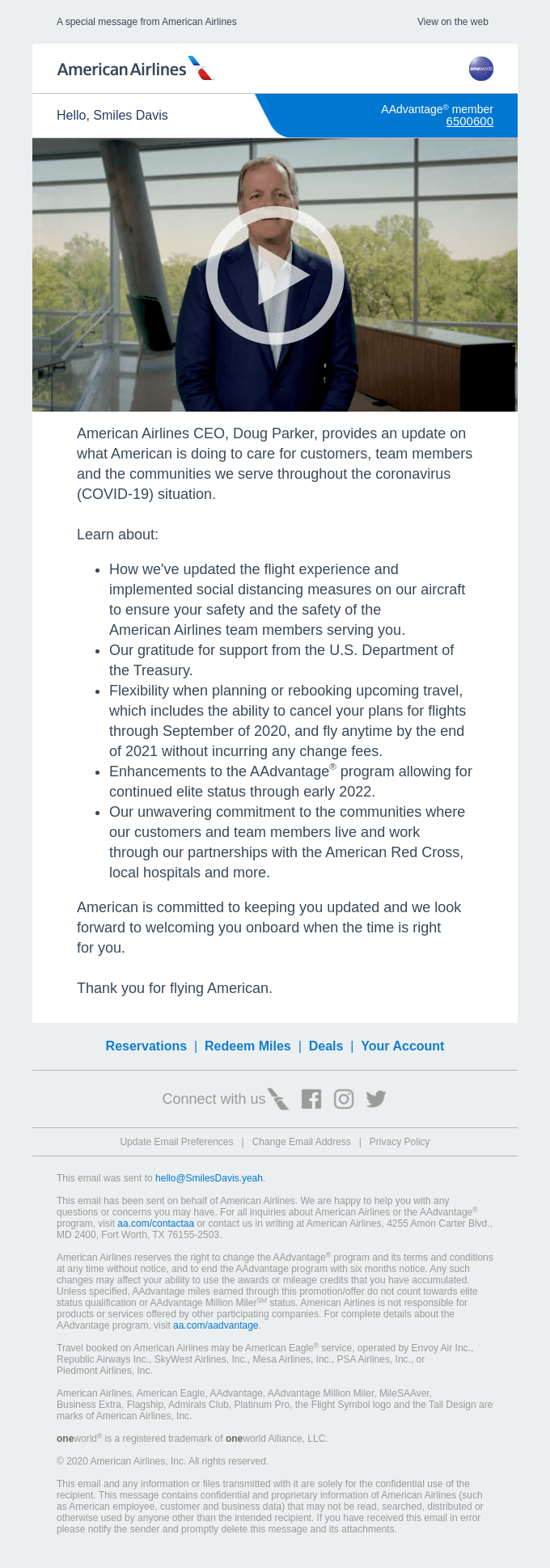
Source: Really Good Emails
9. Insight into your company’s history
This is a classic email format that helps build your brand and share its mythos with the world. As you share your company’s history, you can run your email subscribers through your early days, rise to success, and current landscape.
It helps your email audience imagine the next great achievement you’ll be able to reach. This newsletter idea can also be a way to ask your subscribers to help you reach the next rung in the ladder to success.
10. Important dates to keep in mind
Businesses, nonprofits, education — it doesn’t matter what industry you’re in. There will always be dates that your email subscribers need to know about, whether that’s freshman orientation or the deadline to donate to a fundraiser.
11. Aspirational and aesthetic emails
Not every email needs to be super functional or CTA-driven to be successful. Sometimes, newsletter ideas simply need to inspire and ignite a passion for your brand.
For instance, Glossier’s email campaign merely wants the reader to scroll through beautiful phone backgrounds and maybe download one to use as their wallpaper.
They’re not selling or sharing anything new about their offerings, but they’re creating a mood and a feeling that encapsulates their brand identity in one simple email.

Source: Really Good Emails
12. A product video how-to
Sure, text is great, but try including videos, photos, and other images to provide cool visuals along with the content text. Video is a top way to consume information, and it can keep your email subscribers more engaged (thereby lengthening how long they interact with your newsletter content).
13. Case studies
Social proof is a powerful marketing tool. Showing your audience not only what your product can do, but some of the real people who are using it goes a long way in persuading prospects to become customers — and case studies help you do just that.
14. Little known uses for your product or service
One of the best things about email marketing is how email content can be used to educate and delight users all at once. It’s your job to tell your product’s story and capabilities, and if you can’t think of anything, ask your subscribers!
For example, they might use your vegan moisturizer to cure poison ivy, or wear your signature item completely unexpectedly. It’s a good thing when other people find uses for your goods and services that would’ve never crossed your mind.
15. Updates about new products and releases
In addition to teasing a product release on social media, it’s important to build buzz on email. Get people pre-registered or pre-ordered through your product update email, or create a countdown to the newest drop.
16. An exclusive tip of the month
Quick tip emails can be short and sweet, but they’re a good way to make sure your readers hear from you on a monthly basis about something unexpected.
17. Images of your mobile app in action
Want to drive mobile app downloads? Start by showing off what you’ve built. Aim for enticing imagery (animated GIFs, anyone?) that shows off the functionality and beauty of your mobile app.
18. Partner mobile app reviews
Reviews power the world, and being a trusted resource for partners means sharing the wealth. You can highlight partner mobile app reviews, especially if they’re positive, in your next campaign.
19. Deals and discounts
Deals and discounts (aka incentive emails) are a big deal in the world of email marketing. We all live for the thrill of signing up for a newsletter to get 10% off our first purchase, and there’s a reason companies keep doing it.
Offering discounts through email is simple, proven, and easy to implement. With discount emails, you can set up drip campaigns and automated triggers in your CRM to fire off templated emails with discount codes.
20. A cool new best practice or tip
While email best practices stay pretty evergreen, the rest of the marketing world is subject to constantly changing platforms and new requirements.
To stay ahead, you can share hacks and helpful tips in your emails that’ll help your subscriber base grow their own business or learn a new skill, whether that’s how to kill it on TikTok or a recap on Google’s latest algorithm updates.
21. New vendors for your products/services (like new stores or websites)
Are you an ecommerce business that’s now in-stores for the first time? Or, have you partnered with a vendor to bring your services to new audiences? It’s good to let your email subscriber base know where and when they can find you, whether those are set hours IRL or a 24/7/365 situation online.
22. A top ten list
There are so many opportunities to build your audience with content that’s not directly related to your company or product. A top-ten list aggregates the best of the best on the Internet, but it can also be valuable educational material.
Original, helpful content often performs better than promotions—and constant “me-talk” can grow tiresome.
23. A survey or poll
Looking for information on what product to launch next, or what your audience hopes to see from you next? Put it in a poll or survey and watch the responses pour in.
24. Quotes—motivational or just plain funny (if appropriate)
This kind of email newsletter idea will depend on the type of brand you run. If you’re a serious, reputable corporate voice, sharing funny quotes might not be the right direction for your content.
If you’re inspirational — like say, Nike — an email newsletter chock full of motivating quotes might feel uplifting to your subscribers.
25. Recent studies or surveys related to your business
Surveys and studies provide insight into your business. They tell you exactly what your users are telling you they want. Sharing the results of studies and surveys is transparent, and it also shows your email subscribers that you’re listening to feedback and constantly iterating.
26. Statistics and data points
Most B2B marketers are hungry for citable, reputable statistics and data that they can use in their content. If you’re in the business of creating content, it might be valuable to share survey data and findings in your email content.
Statistics are easily shareable and often, your brand or business will get a link back when others use your stats in blog posts.
Check out how Asana teases the results of a survey with inputs from 5,000+ respondents on the realities of remote work.
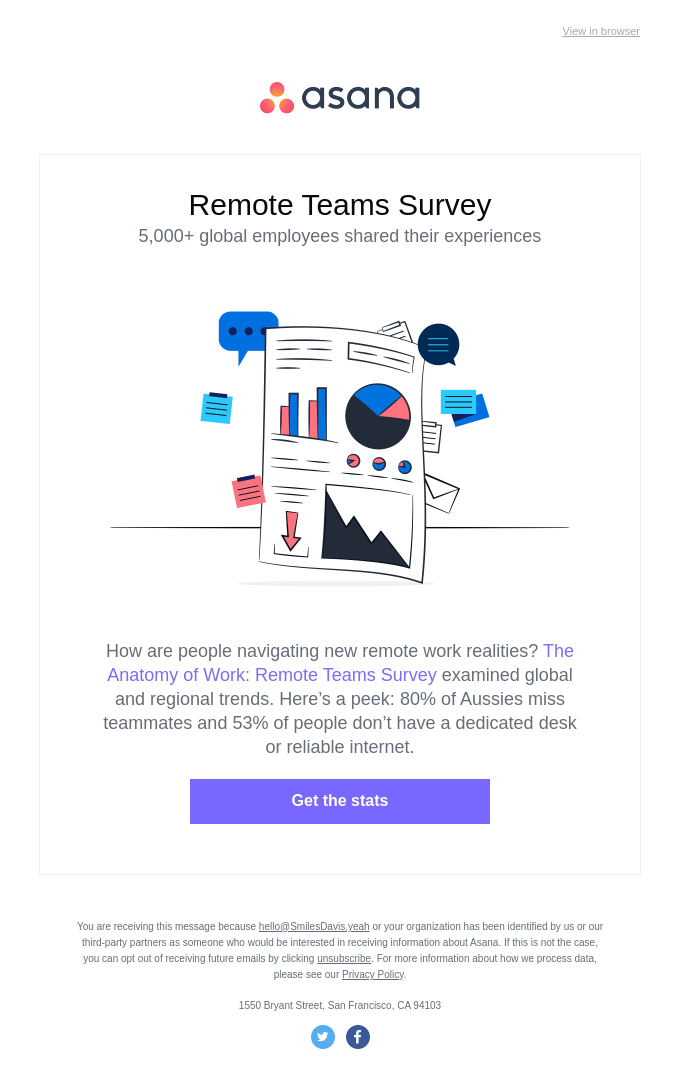
Source: Really Good Emails
27. Infographics
Sending text-heavy emails lately? Mix things up with infographics, which are more visual and dynamic for your reader. You can even make “Year in Review” infographics that collate user data into meaningful storytelling. Think Spotify Wrapped, but for email marketing.
Look at YouTube’s infographic style “2021 snapshot” email. It pulls together data and visualizations to show the user’s YouTube channel growth.

Source: Really Good Emails
28. Updates about your social channels
Every brand and business uses social media these days. It’s practically mandatory in today’s digital-first world. That’s why sharing updates about your social channels with your email list can be helpful for your brand.
You can encourage readers to follow along on other channels, like Instagram or Twitter, especially if you’re more active there than you are on email content.
29. A guest blog post you’ve written for another company or brand
Guest posting is fun. It gives you a chance to introduce your writing or business to an entirely new audience (the guest blog) who may not have ever heard about you before.
Another way to get eyes on that content? Talk about your guest post in an email newsletter.
30. Third-party apps and tools your audience would find useful
A rising tide lifts all boats, right? So why not apply that sentiment to other businesses, helpful tools, and third-party apps your subscribers would love to download and use?
Rather than plugging your own goods or services, you can round up five or 10 of your favorite online tools, apps, or physical products.
31. A roundup of your most popular blogs, videos, or services from the month or year
Round-ups can be a regular rotation in your email marketing strategy. They’re agile and fast to put together, and help your readers stay in the loop on everything you’re publishing in a given month (or year). Plus, it helps recirculate older content and gives it new life.
32. Use your email newsletters to spotlight your teams and add personality
Building personal relationships with your subscribers helps you develop brand loyalty and a sense of trust—and people are more likely to trust your business if they know that real, live people work there.
33. A team spotlight with pictures and bios
Employee appreciation comes in all sorts of forms, including newsletter content. For a team spotlight, you can highlight one team member or several.
Make sure to keep the bio light and fun; you might want to include personal details about your team — like their favorite movie or Starbucks drink of choice — to keep things light and fun.
34. An interview with one of your executives
Does your CEO or CMO have a unique point of view that’s perfect to share with your newsletter list? Are you a small business owner who wears many hats? Interview content can be a great way for people to get to know your company or brand values.
For an informal take on an exec interview, you could ask them about their rituals, habits, and routines as entrepreneurs. It doesn’t have to be all business to be interesting to your reader.
35. A “Dear Abby” type advice column
Newsletters with a personal spin can be really effective and memorable reads for subscribers. In one email, you can ask people to submit their questions and what they need advice on, then follow up with a response to one of the messages you received.
36. Photos your customers have shared
User-generated content (UGC) is a gift that keeps on giving. You can leverage UGC in social media posts, sure, but you can also aggregate your user’s best photos in a gallery or grid for your next email send.
37. A blog post from someone on your team
Sharing new perspectives helps keep your newsletter content fresh and varied. A couple of ideas for blog post content: share someone’s point of view on a trending topic, publish a company update from a person on a different team in your company, or tell a unique story.
38. A meet-the-customer-support-agents post
Your customer support agents work hard, and they deserve a shoutout from time to time! By making your support staff more human and real in the eyes of your subscribers, you can minimize
39. Positive feedback from customers
Reviews and social proof are two of the most powerful forms of selling out there. Sharing your customer feedback in an email can make someone decide to buy your product then and there.
40. Information on your customer loyalty program
Many newsletter subscribers sign up for your emails to learn more about perks, incentives, and loyalty programs. You can send out an automatically triggered email once they sign up detailing your brand’s customer loyalty program.
For example, you might share all the details of your point system or send readers to an FAQ blog post about your loyalty program.
41. A “Thank You” to donors, event attendees, or customers
Saying “thank you” in your newsletter content is one of the easiest types of sends to automate. For customers, you can trigger a thank you campaign upon purchase. Or, if you have an event every year, you can program a thank you email to send days after the event.
Thank you emails are something every brand does, and they help your customers remember you.
42. Frequently asked questions (FAQs) with answers
Newsletters are also a great way to proactively reduce the volume of help desk calls or emails.
Posting FAQs, challenge resolutions, resources, and training classes helps people find the answers they need without involving your customer service department.
43. A customer service case and resolution
If you’re an ecommerce brand or someone in the business of selling products, you probably get a lot of similar customer service requests. Rather than attend to each ticket individually, you can create “Troubleshooting 101” email content that highlights exactly what happened to the customer and how the issue was resolved. Repeat for all your most recurring tickets.
You can share info about things like shipping delays (and why they might happen), nuances about how to use the product in question, and more.
44. Before and after stories
What could be more effective than a “before and after”? It’s a quintessential marketing technique to show how much better someone’s life is before and after they found your product/offering/solution to their problem.
Remember, when it comes to before and after, pictures really do say a thousand words.
45. New training opportunities
For B2B brands, training is not only a huge content opportunity for blogs, white papers, video courses, and ebooks. It’s also a chance to drum up exciting email content with links to online training, insights from experts, and more.
You can encourage registration for a particular training and direct subscribers to a sign-up page. Or, you can offer an exclusive deal for the training exclusively for newsletter subscribers.
46. Free resources, like white papers and guides
Everyone loves a freebie — even over email! The beauty of a newsletter that shares a free resource is that it only needs one primary call-to-action, like “read our guide” or “download our ebook.”
Free resources share your knowledge with your subscribers (who might read and repost your content on social media) and increase your share of voice.
47. Upcoming events and webinars
Events and webinars are marketers’ bread and butter. It’s smart to keep your newsletter subscribers in the loop about what’s coming up for your brand or company, especially if it’s an educational opportunity that can get them further down your marketing funnel.
You’ve probably promoted the event in other ways, so this is just an additional chance to build excitement, sell tickets, or increase views.
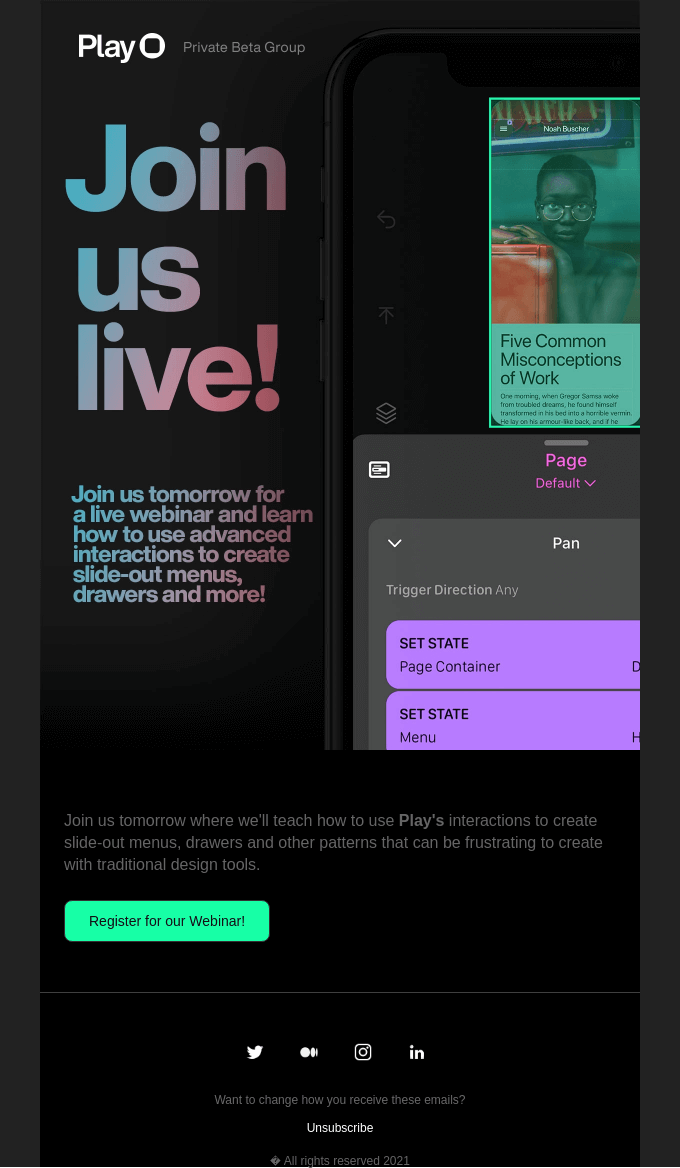
Source: Really Good Emails
48. Webcast recordings of past events
Give old webinar content or virtual events new life by repurposing them for an upcoming newsletter blast. You can build buzz for an annual event by lifting the curtain on what you talked about the year before. Show your newsletter subscribers why they don’t want to miss your events.
49. Information about an event you’re sponsoring
Giving your subscribers information about an event you’re sponsoring doesn’t have to be boring. Add a video announcement or create a GIF with the date, time, and other relevant info, whether you’re sponsoring a 5k or putting on a fundraiser.
50. Community service initiatives
Use your newsletter to shout about company or community-led opportunities! For example, if you partner with a local food kitchen to distribute meals in your area, see if your subscribers want to pitch in time (or donate funds) to the cause. Or, use this kind of newsletter to aggregate upcoming community service opportunities in your area.
Wrapping up
We hope these 50 email newsletter ideas put you in the fast lane for upping your email newsletter game.
Remember, your readers have chosen to receive these emails, so they want to hear from you on a regular basis. Don’t flood them with info, but do offer great content on a regular basis.




